
Oils and Vegetable Fats.
Compiled and edited by Ivor Hughes.
OILS AND VEGETABLE FATS.
VEGETABLE oils are of two distinct kinds, viz. fixed oils, as coconut, gingelly, and castor oils, which do not evaporate on exposure to the air, and volatile, or essential oils, e.g. citronella, cinnamon, and clove oils, which readily volatilise on exposure. The former are obtained by crushing and pressure or by boiling, sometimes by chemical solvents; while the latter are extracted usually by distillation and generally possess the characteristic aroma of the plants from which they are derived. The former include " drying oils " (which dry fairly rapidly, leaving an elastic film), " non-drying " or " semi-drying " oils, and vegetable fats. Some fixed oils which are liquid in a warm temperature become solid in cold, e.g. coconut-oil; others are naturally fatty bodies, resembling grease or butter, e.g. those obtained from Bassia, Butyrospermum, Pentadesma, etc. The following are some of the principal fixed oils.
FIXED OILS
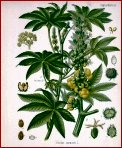
sometimes for shade, as in arid or desert regions. It is suited to a wide range of climate and soil.
Cultivation. The plant thrives in ordinary land, even in brackish or
saline ground, but does best in rich loamy or alluvial soil. Excessive
moisture is unfavourable to the crop, but a moderate rainfall in its early
growth is desirable. About 10 lb. of seed is sufficient to sow an acre,
allowing 3 or 4 seeds to each hole, the latter being spaced about 6 x 6 ft.;
the seedlings should afterwards be thinned out, leaving one to each hole.
The seeds germinate in 8 - 10 days. The plants should be topped at a height
of about 3 ft. They begin to bear in about 4 months from sowing, and the
harvest may be completed about 3 months later. Castor is usually grown in
India as a mixed crop, and in S. Persia and Iraq as a shade tree.
Yield. Planted as a pure crop, the yield under favourable conditions
may be 20-25 bushels of seed (" beans ") per acre; as a mixed crop
10-12 bushels is a fair average crop (about 40 lb. = a bushel). A single
tree may give as much as 6-10 lb. In the United States as much as 30 bushels
or 1,400 lb. per acre is sometimes obtained. The well-known oil has been
used from time immemorial as a purgative, being known to the Greeks and the
Romans 500 B.C. It is obtained from the seeds by pressure. Besides its use
in a refined state in medicine, it is largely employed as a body for
lubricating oils, also for dressing leather, in soap manufacture, etc. The
residue (castor cake or poonac) after the expression of the oil is a
valuable manure, but is unfit for cattle-food; it is largely used for crops
in the tropics. The seeds as well as the poonac contain an
Varieties. These vary in habit of growth, size and markings of seed,
etc. The large-seeded varieties yield a smaller percentage of oil, which is
of inferior quality and is used mainly for lubricating and lighting purposes
; while those with the smaller seeds contain a larger proportion (38�40%
against 25-30%) and finer quality of oil, which is preferred for medicinal
purposes. R. zanzibarensis is noted for its large seed. Medicinal castor-oil
is now quoted at about �36 per ton in London.
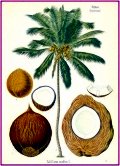
The kernel (endocarp) yields a valuable fatty oil, locally used in cooking, lighting, etc., and largely exported for use in soap-making, margarine, lubricants, etc. In the fresh state the kernels are shredded and made into desiccated coconut, largely exported for use in confectionery. The husk (pericarp) when retted for about 3 weeks in water yields coir-fibre, which is made into mats, brushes, matting, mattresses, etc., or into coarse string and ropes, which are exported for use as binder twine, etc. Some 21 million whole nuts are exported from Ceylon annually.
Copra of commerce, the source of coconut oil, consists of the dried kernels. It is prepared by breaking the nut in two; the two cup-shaped halves, being easily separated from the shell, are then dried in the sun or in specially constructed low houses or kilns, over smoke and heat from smouldering fires made with the husks and shells. Forced hot-air driers are sometimes used for the purpose, the copra shells being placed in movable trays. Ceylon copra contains about 65% of oil and ranks with the finest quality. Some 6,500 tons copra were exported in 1933, valued at about �8 per ton, in addition to large quantities of the oil. From 1,000 to 1,300 nuts, according to size and thickness of kernel, go to a Ceylon candy of copra, and 4 candies = 1 ton. In Malaya, Philippines, etc., copra is sold by the picul (133 lb.). 250-330 nuts go to a picul, and 16 piculs = 1 ton.
Ceylon oil is now quoted at about �22 per ton, against �55 in 1925. Poonac (residue after expression of oil from the copra) is a valuable cattle-food and fertiliser.Toddy and Arrack. The sweet juice extracted from the spadix by
incision and " tapping," when fresh and unfermented is known as
toddy and forms a pleasant, sweet beverage; fermented and then distilled, it
yields arrack, a strong alcoholic spirit. (See Palm Sugar.) For
toddy-drawing, the best and healthiest trees are selected. Tapping may
continue for 6 or 8 months in the year, according to climate, and the yield
may be 40 gall, or more per tree in that period. Each inflorescence may be
tapped daily for 2 or 3 months. From 6� to 7 gall, toddy produce about 1
gall, arrack of 25 degrees under proof. Fresh arrack is sold retail at about
Rs. 8 to Rs. 10 per gallon. Arrack improves with age ; old spirit fetches
the highest price. The extraction of toddy means of course the sacrifice of
the nut-crop.
Cultivation. The palm requires a hot and moist climate, deep alluvial
or loamy soil, thriving especially near the seaboard, but also to a
considerable distance inland provided climatic conditions and soil are
suitable. Rocky, laterite, or stagnant soil are unsuitable. In Ceylon it
thrives up to about 2,000ft. It is propagated by the large, ovoid (bluntly
3-angled in husk) nuts, which are sown in the husk in. nursery beds, being
laid on their sides and almost covered with soil. These germinate in about 3
months, and in 10 months the seedlings, with nut attached, are ready for
planting out. Or the nuts may be planted in situ in well-prepared holes. The
holes should be not less than 3 ft. deep by 3 ft. wide, and should remain
open for some time previous to planting. After planting, they should at
first be only partially filled with good surface soil, to which may be added
some well-decomposed manure. In course of time the holes become filled
through the process of cultivation and weathering, and the plants are thus
ensured protection when young and a firm hold of the ground when grown up.
Planting distances depend on soil and locality; 30 x 30 ft. is sometimes
adopted, but 26 x 25 ft. (70 to the acre), or even closer in less favourable
conditions, is more common.
Yield, etc. A small crop may be obtained when the palms are 7-8 years old ; but they may not be in full bearing till about the age of 15 years. They continue to yield profitable crops until about 50 years old, fruiting all the year round. The crop per tree may vary from 40 to 80 nuts a year, and an average of 3,000 nuts to the acre is considered a satisfactory yield, though it may be as much as 4,000 or more. With good cultivation, under favourable conditions, 4,000 nuts should give 1 ton copra, besides 6 cwt. coir-fibre. It is usual to make six rounds of plucking a year, i.e. once in two months. Heavy clusters of nuts should be supported by means of a forked stick, with a pointed end, placed against the stem at the base of the leaves. The palms attain a height of 60-80 ft., with an unbranched, wavy stem. They are readily climbed by coolies, who throw their feet in a loop of cloth, rope, or fibre, pressed against the stem and are thus afforded a foothold. In Ceylon and S. India the ripe nuts are picked by hand, but in some countries they are allowed to fall to the ground as they ripen, and are then gathered.
Varieties. Numerous varieties occur in cultivation, these varying in size, shape, yield, thickness of husk and copra, height of tree, etc. Some of the more distinct varieties are known by different local names. King Coconut (Tambili, S) is a distinct variety, said to have originated in Ceylon, bearing a yellow, ovoid fruit, distinguished by its sweet juice and esteemed for culinary purposes, but it is of little commercial value for copra. The " Dwarf Coconut" (" Nyiur-gading " of Malaya) bears fruit when about 4-5 years old and when the stem is only 2 or 3 ft. high, the nuts being small but numerous. Of these, an average crop of 100 nuts per tree may be expected when the palms are 8 years old, so that with 90 trees to the acre (24 x 20ft.) a yield of 9,000 nuts per acre may be obtained. 500 "dwarf" nuts may go to a picul of copra. Some plantations of this variety have been made in Malaya. The " Needle Coconut," cultivated in the Nicobar Islands, has a long triangular fruit, the nut tapering to a sharp point at the end. The " Maldive Coconut" is characterised by a small, almost round, fruit; while the '' Na-wasi" or the edible-husked coconut is furnished with a husk which, when tender, is fleshy and of a sweetish-acid taste.
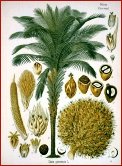
Cultivation, etc. The palm thrives in a hot, humid climate and low-lying alluvial soil. It requires similar climatic conditions to Cacao, and a somewhat lower rainfall than the Coconut palm. In Ceylon, where it was introduced in 1850, it grows luxuriantly up to about 2,000 ft., also in the N.C. Province with a rainfall of 60-70 in. Extensive areas have recently been planted under the product in the Dutch E. Indies and Malaya, from which the oil as well as kernels are exported.
Propagation and Planting. Fresh seeds may germinate in about 4 or 5
months after sowing, but often take 8 months or longer. Germination may be
hastened by soaking the seeds in hot water for a few days, or by placing
them between layers of stable manure so as to set up fermentation. Seedlings
may be planted out about 8 months after germination or when about 2 ft.
high, being spaced 28 x 28 ft. (55 palms to the acre) or, as is more usual,
26 x 26 ft. Wide spacing has the effect of developing stout and short stems,
thereby facilitating harvesting of the crop besides being more productive.
The palms begin to bear when 4 - 6 years old, and should be in full bearing
at the age of 12 -15. After the age of about 30 years the yield gradually
declines. The outer covering (pericarp) of the fruit yields "palm
pulp," or "pericarp-oil." This is largely used in W Africa
for cooking and to some extent for lighting, being obtained by boiling and
pounding. It is largely exported for use as a lubricant and in the
manufacture of soap, etc. Distinct from this is the " kernel " or
" white-oil," obtained by machinery or solvents, which is the more
valuable and is largely used for margarine and cooking-fats. The residual
cake is a valuable stock feed and is usually worth about �8 per ton.
Yield. The average annual yield of fruit per mature tree in an
uncultivated state is variously estimated at from 60 to 80 lb. or more, but
cultivated palms may give double these figures. Rutgers * estimates as
follows for Sumatra plantations : 5th - 10th year, average 53 lb.
of nuts per tree ; 11th � 30th year, 165 lb.; 31st
� 50th year, 66 lb. Each mature palm produces from 5 to 10 bunches a year,
each weighing from 20 to 40 lb. or more according to age. An acre of mature
trees is considered to yield 4 tons of fruit, or � to � tons of kernels.
In 1925, before the general slump in values, Palm kernels were quoted in
London at about �20 per ton, Kernel oil at �45, and Palm or Pericarp oil
at �38-�40.
Varieties. Numerous varieties or sub-varieties are recognised, these
varying in yield as well as in quality, size and colour of fruit, which may
be green, red, black, or dark purple, with thick or thin shell. Many are
given local names, as Abe-pa, Opa-pankoro, Ope-arunfo, Osok-eyop, Potshi,
Qua-qua, etc. The " Deli " type has a good reputation in Sumatra.
The variety " King Palm " is held sacred in W. Africa and yields
" Holy Oil." " Soft oil," valued chiefly for cooking, is
obtained by fermenting, pounding and boiling the pericarps.
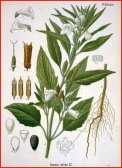
Cultivation. The plant is grown as a summer crop in warm or subtropical countries, as in S. Italy, S. United States, Iraq, etc., and thrives in light friable soil with moderate rainfall. After the land is well tilled the seed is sown broadcast, or in drills about 1� ft. apart, at the rate of 8-10 lb. per acre. The crop is ripe in about 4 months, and is then cut, tied in bundles and stocked. If allowed to become ' fully ripe the pods will burst and disperse the seed. In India the usual yield is about 400-600 lb. per acre, producing about 10 gall. oil. The residue (Gingelly-cake) is a valuable cattle-food. The seed is quoted in London at about �20 per ton. Some 4 million acres are estimated to be under the crop in India alone.
Cotton-seed Oil
.One of the most important sources of commercial oils is cotton seed after it has been separated from the fibre. The best seed yields 20% or more of oil, which is largely used in the manufacture of soap, paint, etc., and refined qualities in salad oils. The supply of cotton seed is an important part of the industry in cotton-growing countries. The seed is now quoted in London at about �6, and the oil at �25, per ton.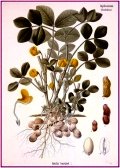 Ground-nut
Oil. One of the most important of
commercial oils, obtained by pressure from Groundnuts, which are extensively
exported from India, Africa (East and West), Sudan, Java, etc., both in the
decorticated and undecorticated state, the former coming chiefly from
Coromandel, China and Java, and commands the highest price. Nuts now quoted
at about �15 per ton and the oil at �25 to �30.
Ground-nut
Oil. One of the most important of
commercial oils, obtained by pressure from Groundnuts, which are extensively
exported from India, Africa (East and West), Sudan, Java, etc., both in the
decorticated and undecorticated state, the former coming chiefly from
Coromandel, China and Java, and commands the highest price. Nuts now quoted
at about �15 per ton and the oil at �25 to �30.
Linseed Oil.
Olive Oil. Considered the best of all salad or culinary oils. It is obtained by pressure from full-grown but unripe fruit, and very largely used for domestic purposes and medicine. Seeds quoted about �12 per ton.
Sunflower Oil. (Helianthus annuus. Compositae.) A tall, quick-growing coarse annual, 5-8 ft. high or more, native of Mexico, etc., extensively cultivated in parts of India, China, S. America and elsewhere for the seed, which yields a valuable edible oil. The plant thrives in ordinarily good soil with a warm and moderately moist climate. Different varieties are commonly grown, for ornament or utility, in all warm countries, thriving in the tropics at medium and high elevations. The seed may be sown in rows 3 ft. apart, about 8�10 lb. being required to sow an acre. The seedlings are afterwards thinned out to about 12 or 15 in. apart. The ground should be well tilled and manured.
Yield. A crop is obtained in about 4 months after sowing, yielding
30-40 bushels of seed per acre, which should give nearly a gallon of oil per
bushel, or about 30%. The method of harvesting is similar to that of Maize,
the heads being gathered, dried, and then threshed ; or the seeds are rubbed
out by hand over a coarse grater. Sunflower seed for oil extraction is
usually worth about �17 per ton. The oil, which is obtained by pressure, is
edible and of a pleasant flavour: The seed, roasted or boiled, is sometimes
used as an article of food, and forms a nutritious food for cattle and
poultry. The residue after the extraction of oil makes a good cattle-food.
Soya-bean Oil.
A very important oil, both for culinary and industrial purposes, obtained by pressure from the seeds (beans), which are largely exported from Manchuria. They contain about 18% of oil, and are now quoted in London at about �8 per ton, the " crude oil " being �16 to �18.Tung or Wood-Oil.
(Aleurites Fordii. Euphorbiaceae.) A small tree of China, suited to high elevations or subtropical conditions with moderate rainfall. The kernels yield a valuable " drying " oil, largely used in the paint, varnish and linoleum trades, with an increasing demand ; also locally for lighting, lacquer-work, etc. The oil-cake residue, being poisonous, is only fit for manuring.Other species which are valuable sources of oil are : A. cordata (Japanese Wood-oil) and A. montana, both natives of S. China and requiring similar conditions to the above. A. moluccana (= A. triloba) is a native of Malaya and Pacific Islands and is widely distributed in the tropics, being naturalised in India, Ceylon, Madagascar, W. Indies, etc.
It is familiar as Candle-nut Tree, Country Walnut, Eboc, Kukui (Hawaii), Bankul (French Colonies), Tel-kekuna (Ceylon), and is suited to tropical conditions up to 3,000 ft. The nuts are rich in oil and sometimes strung together and used as candles. A. trisperma, known as Balucanat in the Philippines, is similarly rich in oil. An average Tung tree may produce 100-150 lb. of nuts a year, yielding about 35-40% of oil. The seeds may take about 2 to 3 months to germinate. The first named has recently been planted on a commercial scale in certain subtropical climates. It is said to give 5 tons seed (1,800 lb. oil) per acre of 60 mature trees.
Vegetable- or Chinese-Tallow.
A product of Stillingia (Sapium) sebifera (Euphorbiaceae), a small tree, about 30 ft. high, native of China and Japan. The fatty oil obtained from the layer surrounding the seed is used in China in place of animal tallow for the manufacture of candles and soap, also in cloth dressings, etc. The kernels yield a yellowish oil used by the Chinese in the preparation of varnishes and for lighting, etc., and a mixture of the oil and fat is stated to form a good substitute for lard for industrial purposes. Vegetable-tallow is exported from China in hard white lumps, weighing about � cwt. each. The tree was introduced to Ceylon before 1824 and has become naturalised in the vicinity of some up-country gardens, where it seeds abundantly. Birds are fond of the fruit, which probably accounts for the local distribution of the tree.OTHER FIXED OILS
Argania Sideroxylon.
Argan-oil. (Sapotaceae.) Medium-sized tree of Morocco, where it is largely cultivated. Seeds yield an oil used in cooking and said to be almost equal to olive oil. Leaves and fruit are a valuable food for stock in N. Africa.Attalea Cohune
. Cohune-nut. (Palmae.) Kernels, the size of a hen's egg, yield an oil similar to coconut-oil and suitable for use in margarine manufacture. Charcoal made from the fruits was largely used for gas masks in the late war.Azadirachta indica.
Margosa (Portuguese); Nim- or Neem-tree of India; Kohomba, S; Vempu, T. (Meliaceae.) A tall tree of India, Ceylon, etc. The strong-smelling, aromatic oil obtained from the fruit is much valued in native medicine, being a well-known application for leprosy, rheumatism, etc., and is taken internally by women in pregnancy. It is commonly used for animals, both internally and externally. A most valuable tree to the peasants, all parts being used for medicine or domestic purposes.Balanites Manghamii
. Manduro. (Simarubaceae.) A tree of Portuguese E. Africa. The nuts yield a clear oil, burning with a bright flame, much used locally. B. aegyptiaca. " Desert Dates." A tree found in drier parts of W. and Cent. Africa. Fruit edible and yields a clear oil called Betu- or Zachun Oil.Bassia butyracea.
Indian Butter-tree. (Sapotaceae.) A medium-sized deciduous tree of Cent. India, occurring at 1,000 - 5,000 ft. The seeds yield by expression a thick oil or fat used locally for burning and externally for rheumatism, etc.; also used as an adulterant in " ghi." Flowers not generally eaten, but a syrup prepared from them yields a spirit or is made into sugar. B. latifolia. Mahua or Mahwa ; Mowra. A large, spreading tree with broad leaves, common in Cent. India up to 4,000 ft., often cultivated and of importance locally. From the seeds is obtained a thick, yellow oil or fat known as " mowra fat," commonly used in India for cooking, etc. The seed was largely exported before the war, chiefly to Germany, the oil being used in margarine, soap and chocolates. Mowra-cake is not suitable for cattle food, but makes a good fertiliser. B. longilfolia. Mi or Mee, S ; Ilippi or Illupai, T. A large tree of Ceylon, Malaya and S. India. Often cultivated for the fleshy seeds, which yield an oil esteemed locally for cooking, also used in medicine, etc. The cake, after the expression of the oil, is known as " arippu," and is exported from Ceylon to S. India as a fertiliser. The tree is deciduous for a short period in the dry season. From the fleshy edible flowers is obtain a spirit.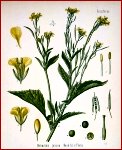
Calophyllum Inophyllum.
Carapa-, Crapa
or Crab-oil. Carapa guianensis. The large fruit contains numerous seeds which yield an oil used in Guiana, etc., for medicine, lighting and other purposes.Carthamus tinctorius. Safflower Oil. Kusuma. Largely cultivated in India, Egypt, Caucasus, etc., for the seeds, which yield safflower oil by pressure. The oil is used in India for culinary purposes, but chiefly in the manufacture of paint and soap and for dressing leather. A dye is obtained from the flowers.
Diospyros Embryoptefis. Tunka Oil. Timbiri. Used medicinally in India.
Dipterocaipus glandulosus. Dorana-tel, S. (Dipterocarpeae.)-A tall, erect tree of Ceylon. A resin which exudes naturally from the stem and is collected at the base, yields an oil used in medicine, etc.
Dumoria Heckeli. Bako-nuts. (Sapotaceae.) The large, ovoid, smooth seeds, with a large oval scar along one side, are obtained from a large tree, 100 to 150 ft. high, of W. Trop. Africa and are rich in oil, edible and valued for soap-making.
Garcinia echinocarpa
Guizotia abyssinica. Ramtil-, Inga-, Black-til- or Niger seed-oil. (Compositae.) An annual, largely cultivated in India and Africa for the oil obtained from the seed ; used locally for cooking, lighting, and medicine, and exported for use in margarine, etc. Seed commonly used as food for cage birds. Yield, 300-400 lb. per acre.
Gynocaidia odorata. (Bixaceae.) Large tree of Sikkim, etc. Bears large globular fruits, the seeds of which yield a drying oil of good quality, known as Gynocardia-oil. This was formerly supposed to be the source of Chaulmugra oil.
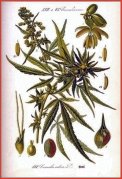
Hemp-seed Oil.
Obtained by pressure from the seed of Cannabis sativa or Indian Hemp. It is of a greenish-yellow colour and used chiefly in paints and varnishes ; produced largely in China, Formosa, Algeria, etc. Hemp seed is quoted at about 20s. per cwt. It is also used for bird-food.
Hydnocarpus anthelminticus
and H. wightiana. " Kavatel." (Bixaceae.) Medium-sized trees of India, Burma, etc. An oil similar to Chaulmugra oil is obtained from the seed and used in the treatment of leprosy." Illipe" Edible fat- or oil-yielding seeds of Bassia (in India), Shorea (in Java), Isoptera (in Borneo, etc.).
Irvingia Olivera. Cay-cay or Dika. (Simarubaceae.) A slow-growing, straggling tree of Indo-China, the kernels of which are edible and rich in fatty matter.
Jatropha Curcas. Physic-nut; Pulsa- or Purqueira-oil; Rata-endaru, S ; Kaddamanakku, T. A well-known shrub, commonly planted as a fence round peasants' gardens, being readily propagated from large cuttings . Cultivated in Portuguese W. Africa. A strong purgative oil obtained from the seed is used in native medicine and exported to Portugal for use in soap and candle manufacture. Residual cake poisonous.
Kokoona zeylanica.
Kokun-oil ; Potha-eta-tel, S. (Celastraceae.) Large tree of Ceylon and S. India. Seeds yield oil used for lighting and medicine.Lophira alata.
Scrubby Oak. (Dipterocarpeae.) A small ornamental tree, native of Sierra Leone; yields an edible fat known as Kiam- or Meme-butter.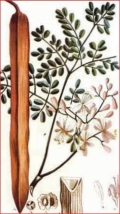
Moringa pterygosperma.
Moringae. Horse-radish Tree ; Drumsticks; Mu-runga, S; Murunga-kai,
T. A short, slender tree, about 25 ft. high, with small tri-pinnate leaves,
cultivated in gardens throughout Ceylon, India, etc. The roots are used as a
substitute for horse-radish, the leaves for vegetable curries as well as for
seasoning and in pickles, and the 2-4 ft. long unripe pods ("
drumsticks ") as a curry vegetable, the latter being boiled and sliced
like beans. The flowers and bark are used in native medicine, a The seeds
yield a fine oil known as Oil-of-Ben, used by watchmakers and in
cosmetics.
Propagated by seed or cuttings.
Pentadesma butyracea
. Tallow- or Butter-tree; Okoto- or Koma-nut Oil. (Guttiferae.) A large tree with long, straight, regularly radiating branches, native of W. Trop. Africa. The large, oblong fruit (5-6 in. long by 3� in. diam.) and large fleshy seeds (3 - 4 in each fruit) contain a quantity of yellow, waxy juice, which is used by the natives for the extraction of an edible oil. The oily seeds were valued in England in 1925 at �8 per ton. An average tree bears 700 - 900 fruits or about 150 lb. of seed a year. Introduced to Ceylon 1897, and bears a heavy crop of fruit each year, during April - May.Poppy-seed Oil.
Derived from the seed of Papaver somniferum used in artists' paints, etc., and exported chiefly to France. Average yield of seed per acre, about 4 cwt.Quillai Bark
or Soap-bark Oil. (Quillaja saponaria. Rosaceae.) Small tree of Chile, etc., with saponine bark, readily raising a lather in water ; used locally as Vegetable soap, also exported and now quoted at about 34s. per cwt.Sapindus emarginatus. Penela, S; Neyk-kodan, T; Soap-nut. (Sapindaceae.) A large tree of Ceylon (dry region), India, Burma, etc. Fruits, dry or fresh, are saponine in water and used as a substitute for soap.
S. Saponaria.
Soapberry. Small tree of Jamaica. Fruit strongly saponaceous.Schleichera trijuga. Ceylon Oak; Kusumb of India. (Sapindaceae.) A large tree of Ceylon, India, Burma, etc. Seeds edible and rich in oil, said to be the original Macassar oil.
Taraktogenos Kurzii.
Kalaw or Kalaw-ni. (Bixaceae.) A large or medium-sized tree of Burma, Siam, etc. The large fleshy seeds yield a thick yellowish oil or fat of the consistency of butter, valued in the treatment of leprosy and other skin diseases. This is the true Chaulmugra-oil, formerly supposed to be obtained from Gynocardia odorata The tree was introduced at Peradeniya, Ceylon, in 1922. Cultivated in Hawaii.Trichilia emetica. Malfura or Mafureira-nut. (Meliaceae.) A handsome E. African deciduous tree, yields 60-80 lb. dry nuts per tree. Nuts rich in fatty oil, edible and used in the manufacture of soaps and candles. The residue from the seed is considered poisonous.
Did you find what you were looking for? If not please use the site search box at the top right hand of the page, or else return to the site library.
![]()